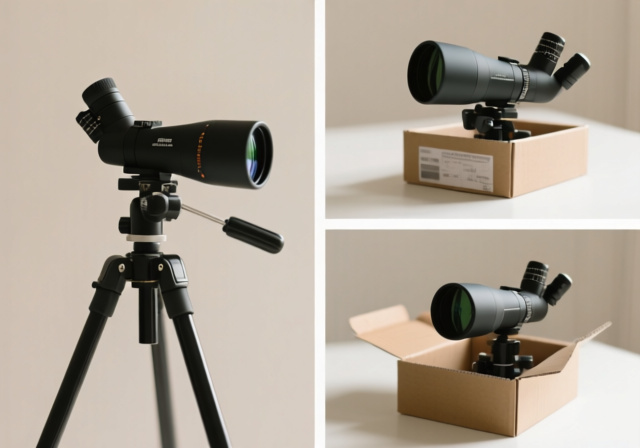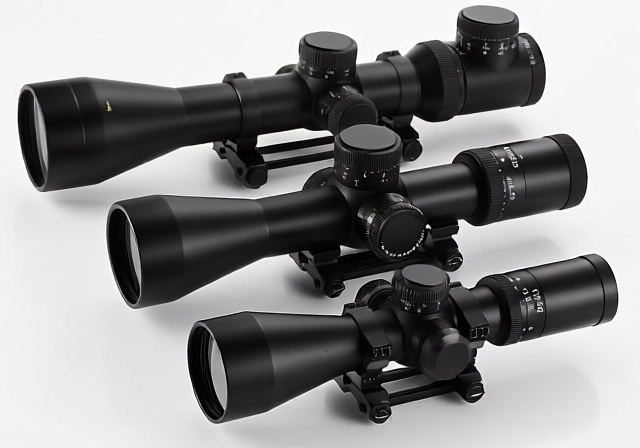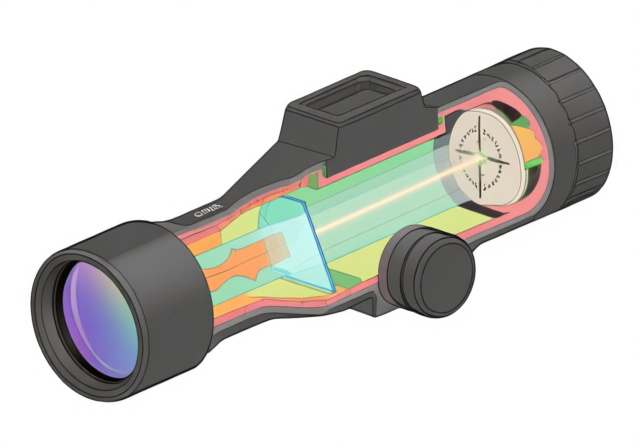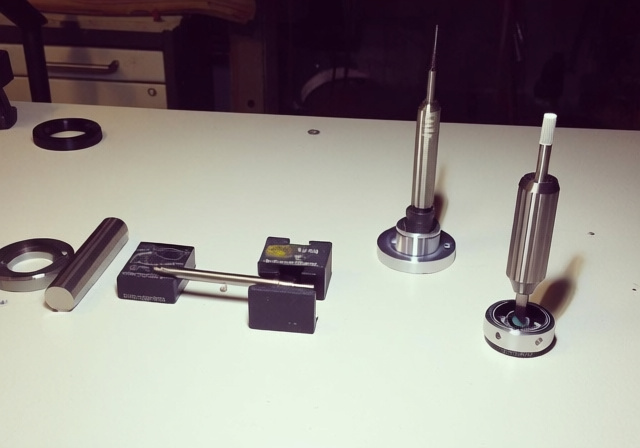



Walking into a sporting goods store and staring at rows of rifle scopes can feel like reading a foreign language. Those mysterious combinations of numbers and letters – 3-9×40, 6×42, 4-16×50 – leave many new shooters scratching their heads.
The numbers on a rifle scope indicate magnification power (before the ‘x’) and objective lens diameter (after the ‘x’), measured in millimeters. For example, a 3-9×40 scope can magnify your target from 3 to 9 times its normal size, with a 40mm front lens that gathers light.
After spending years teaching newcomers about optics, I’ve seen how this simple knowledge transforms confused buyers into confident shooters. Understanding these two numbers is the foundation of choosing the right scope for your specific needs, whether you’re hunting deer at 100 yards or punching paper at 600.
In this guide, I’ll break down exactly what these numbers mean in practical terms, show you how they affect your shooting, and help you avoid common mistakes that cost shooters time and money. You’ll learn to read scope specifications like a pro and make informed decisions for your next optic purchase.
Magnification is simply how much closer your target appears through the scope compared to your naked eye. When you see “3x” on a scope, it means the target looks three times larger than normal. “9x” means nine times larger.
Think of it this way: if a deer appears 1 inch tall at 100 yards to your naked eye, it would look 3 inches tall through a 3x scope and 9 inches tall through a 9x scope. This increased size makes it easier to see details and place precise shots.
There are two types of magnification you’ll encounter: fixed power and variable power. Fixed power scopes have one magnification level (like 4x or 6x), while variable power scopes offer a range (like 3-9x or 4-16x). Variable scopes have become incredibly popular because they offer versatility – you can scan wider areas at low magnification, then crank up the power for precise aiming.
Variable scopes work through a power ring or zoom lever, typically located near the eyepiece. Rotating this ring changes the distance between internal lenses, adjusting the magnification level. Modern variable scopes maintain good optical quality throughout their range, though premium models perform better at the extremes.
✅ Pro Tip: Start with lower magnification when searching for targets. Higher power narrows your field of view, making it harder to find and track moving targets.
Choosing the right magnification depends entirely on your intended use. For most deer hunting within 200 yards, 3-9x provides plenty of power. Target shooters engaging steel at 600+ yards might need 20x or more. The key is matching magnification to your typical shooting distance – too little power and you can’t see clearly; too much and your field of view becomes too narrow for practical use.
I’ve tested dozens of scopes over the years, and here’s what experience has taught me about choosing between variable and fixed power optics:
Variable scopes shine when you need versatility. One day you might be shooting targets at 50 yards, the next you’re stretching out to 400. A 3-9x or 4-12x scope handles both scenarios. They’re perfect for hunters who might encounter game at various distances, or for shooters who use one rifle for multiple purposes.
However, variables have downsides. They’re generally more expensive, heavier, and have more moving parts that can fail. They also require you to think about which magnification setting to use – which can cost precious seconds when a buck suddenly appears at 50 yards.
Fixed power scopes offer simplicity and reliability. A 4x or 6x fixed scope is always ready – no adjustment needed. They’re lighter, more durable, and often provide better optical quality at their price point. Many experienced hunters swear by fixed 4x or 6x scopes for deer hunting, arguing that most shots occur within ranges where these magnifications are ideal.
For beginners learning about optics fundamentals, understanding different types of rifle scopes can help clarify which magnification style fits your needs.
The number after the ‘x’ indicates the objective lens diameter in millimeters. This is the big lens at the front of your scope – its primary job is gathering light. The larger the objective lens, the more light it collects, which means brighter images, especially in low-light conditions.
Think of the objective lens like a bucket collecting rainwater. A 40mm lens (40mm bucket) collects more light than a 32mm lens (32mm bucket). This difference becomes crucial during dawn and dusk when deer are most active but light is limited.
Most hunting scopes range from 32mm to 56mm objective lenses. Target scopes might go even larger – 60mm, 70mm, or more – for maximum light gathering in controlled environments. But bigger isn’t always better, and there are important trade-offs to consider.
Larger objective lenses create several practical issues. They require higher scope mounts, which raises your eye position above the rifle. This can make maintaining a proper cheek weld uncomfortable or impossible without an adjustable comb. Heavy scopes with big objective lenses also affect your rifle’s balance – try carrying a rifle with a 56mm objective scope through thick woods and you’ll quickly notice the forward weight.
Exit pupil is another important concept related to objective lens size. It’s the beam of light that exits the eyepiece, and you can calculate it by dividing the objective lens diameter by magnification. For example, a 4×32 scope has an 8mm exit pupil (32 ÷ 4 = 8). The human pupil can dilate to about 7mm in perfect darkness, so anything larger doesn’t provide additional benefit.
Exit Pupil: The circle of light visible when you hold a scope at arm’s length. Larger exit pupils provide more forgiving eye position and better low-light performance.
For most hunting applications, objective lenses between 40mm and 50mm offer the best balance of light gathering and practical mounting. They perform well in dawn and dusk conditions without requiring excessively high mounts.
Let’s break down the most common scope configurations you’ll encounter and what they’re best suited for:
| Scope Size | Magnification Range | Objective Lens | Best For | Typical Range |
|---|---|---|---|---|
| 2-7×32 | 2x to 7x | 32mm | Close-range hunting | 25-200 yards |
| 3-9×40 | 3x to 9x | 40mm | All-purpose hunting | 50-300 yards |
| 4-12×40 | 4x to 12x | 40mm | Versatile hunting/target | 75-400 yards |
| 4-16×50 | 4x to 16x | 50mm | Long-range hunting | 100-500 yards |
| 6-24×50 | 6x to 24x | 50mm | Long-range target | 200-800+ yards |
| 6×42 | 6x fixed | 42mm | General purpose | 50-300 yards |
| 4×32 | 4x fixed | 32mm | Close-range/brush | 25-150 yards |
The 3-9×40 is arguably the most popular hunting scope of all time, and for good reason. It provides enough magnification for shots at typical deer hunting distances while maintaining a wide field of view at 3x for finding targets quickly. The 40mm objective lens offers good low-light performance without requiring excessively high mounts.
For practical scope applications in various hunting scenarios, the 3-9×40 remains the gold standard for most North American big game hunting.
Close-range hunting in thick woods often calls for lower magnification. A 2-7×32 or fixed 4x scope excels when shots are typically under 100 yards. These scopes provide a wide field of view for quick target acquisition and work well from unstable positions common in hunting situations.
Long-range shooting requires more magnification. Target shooters engaging steel or paper beyond 500 yards benefit from 16x, 20x, or even higher magnification to see distant targets clearly. However, remember that higher magnification also amplifies every slight movement – making these scopes challenging to use from unsupported positions.
⏰ Time Saver: For 90% of hunting situations, a 3-9×40 or 4-12×40 scope will cover all your needs. Focus more on optical quality than chasing higher magnification.
While magnification and objective lens size are the primary numbers you’ll see, modern scopes include other important specifications that affect performance:
Field of view is the width of area you can see through your scope at a specific distance, usually measured in feet at 100 yards. Higher magnification narrows your field of view – a 3x scope might show 30 feet at 100 yards, while a 9x setting might only show 10 feet.
This becomes critical when hunting moving game or trying to locate targets quickly. A wide field of view at lower magnifications helps you scan and find targets, then you can increase magnification for precise aiming.
Eye relief is the distance your eye can be from the eyepiece while still seeing the full image. This matters for two reasons: comfort and safety. Most scopes offer 3-4 inches of eye relief.
Insufficient eye relief on hard-kicking rifles can cause “scope bite” – when the scope recoils back and hits your eyebrow. Trust me, you only make this mistake once. For magnum rifles, look for scopes with at least 3.5 inches of eye relief.
While not a number per se, reticle choice affects how you use your scope. Simple duplex reticles work well for most hunting, while mil-dot or BDC reticles provide holdover points for longer distances. The focal plane (first or second) determines whether the reticle appears to change size with magnification. When learning about first focal plane vs second focal plane reticles, remember that FFP reticles maintain their relationship to target size at all magnifications, while SFP reticles are typically calibrated at one specific magnification.
After helping dozens of new shooters choose optics, I’ve seen these mistakes repeated time and again:
The most common mistake is buying too much magnification. New shooters often think bigger is better and end up with 6-24x scopes for deer hunting they’ll never use past 12x. High magnification narrows your field of view, makes finding targets difficult, and amplifies shake. For most hunting situations, 9x or 10x maximum magnification is plenty.
Larger objective lenses require higher rings to clear the barrel. I’ve seen shooters buy 56mm objective scopes only to discover they need expensive high mounts that make their rifle uncomfortable to shoot. Before buying, check that your chosen scope will fit your rifle with available mounts.
It’s tempting to buy the most powerful scope you can afford, but optical quality matters more than magnification. A high-quality 3-9×40 from a reputable brand will outperform a budget 6-24×50 in every practical way – brightness, clarity, durability, and repeatable adjustments.
Particularly with high-recoil rifles, insufficient eye relief creates safety issues. Always check eye relief specifications and consider your rifle’s recoil characteristics before purchasing.
3-9×40 means the scope can magnify targets from 3 to 9 times their normal size, with a 40mm objective lens that gathers light. This is the most popular hunting scope configuration, offering versatility for various distances while maintaining good low-light performance.
6-24×50 indicates a variable scope with 6x to 24x magnification range and a 50mm objective lens. This high-magnification setup is designed primarily for long-range target shooting or varmint hunting at extended distances, typically 200+ yards.
4-16×50 offers 4x to 16x magnification with a 50mm objective lens. This provides excellent versatility for hunters who might encounter game at close range but need precision for longer shots up to 400-500 yards.
2-7×32 is a low-magnification scope with 2x to 7x zoom and a 32mm objective lens. It’s ideal for close-range hunting in thick cover, quick target acquisition, and situations where shots typically occur under 150 yards.
No. While larger objective lenses gather more light for better low-light performance, they require higher mounts, add weight, and affect rifle balance. For most hunting, 40-50mm provides the best balance of light gathering and practical use.
For most 100-yard applications, 4x to 9x magnification is ideal. 4-6x works well for quick shots at moving targets, while 9x provides precision for stationary targets. Even 1-4x scopes can be effective at 100 yards for close-quarters hunting.
Understanding scope numbers removes the mystery from choosing optics. Focus on matching magnification and objective lens size to your specific needs rather than chasing the biggest numbers on the box.
For most hunters, a quality 3-9×40 or 4-12×40 scope will serve you well across all your hunting situations. Target shooters engaging at longer distances should prioritize higher magnification and larger objective lenses, while those hunting in thick cover should focus on lower power with wider fields of view.
Remember that optical quality, durability, and reliable adjustments matter more than impressive specifications. A quality mid-range scope from a reputable manufacturer will outperform a budget scope with exaggerated specifications every time.





